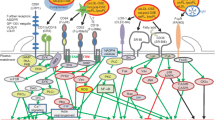Abstract
Cyclophosphamide (CY) is an alkylating agent used for the treatment of various types of cancer and is also used as a potent immunosuppressant. Acrolein, a metabolite of CY is cytotoxic and has the ability to covalently bind with proteins in vitro to form acrolein–protein adducts. These protein adducts are considered to be putative markers of oxidative stress and cause damage to protein in aging, atherosclerosis and diabetes. We have, for the first time, detected acrolein–lysine adducts in plasma low-density lipoprotein (LDL) and in the aorta of CY-treated animals by agarose gel electrophoresis, immunoblot and immunohistochemical methods. The extent of lipid peroxidation caused by the metabolite acrolein in plasma LDL was also measured quantitatively by using high-performance liquid chromatography. These results confirm the role of acrolein–lysine adducts in the development of atherosclerosis or atherogenesis.





Similar content being viewed by others
References
Arumugam N, Sivakumar V, Thanislass J, Devaraj H (1997) Effects of acrolein on rat liver antioxidant defense system. Indian J Exp Biol 35:1373–1374
Arumugam N, Sivakumar V, Thanislass J, Sadasivan Pillai K, Niranjali Devaraj S, Devaraj H (1999a) Acute pulmonary toxicity of acrolein in rats—underlying mechanism. Toxicol Lett 104:189–194
Arumugam N, Thanislass J, Ragunath K, Niranjali Devaraj S, Devaraj H (1999b) Acrolein-induced toxicity—defective mitochondrial function as a possible mechanism. Arch Environ Contam Toxicol 36:373–376
Assruey AMS, Martins GJ, Moreira MEF, Brito GAC, Cavada BS, Ribeiro RA, Flores CA (1999) Prevention of cyclophosphamide-induced hemorrhagic cystitis by glucose-mannose binding plant lectins. J Urol 161:1988–1993
Berrigan MJ, Struck RF, Gurtoo HC (1987) Lipidperoxidation induced by cyclophospamide. Cancer Biochem Biophys 9:265–270
Botta JA, Nelson LV, Weikel JH (1973) Acetylcysteine in the prevention of cyclophosphamide-induced cystitis in rats. J Natl Cancer Inst 51:1051–1058
Calingasan NY, Uchida K, Gibson GE (1999) Protein-bound acrolein: a novel marker of oxidative stress in Alzheimer’s disease. J Neurochem 72:751–756
Chung BH, Wilkinson T, Geer JC, Segrest JP (1980) Preparative and quantitative isolation of plasmalipoprotein: rapid, single discontinuous density gradient ultracentrifugation in a vertical rotor. J Lipid Res 21:284–291
Cohen SM, Garland EM, John MSt, Okamura T, Smith RA (1992) Acrolein initiates rat urinary bladder carcinogenesis. Cancer Res 52:3577–3581
Cox PJ (1979) Cyclophosphamide cystitis—identification of acrolein as the causative agent. Biochem Pharmacol 28:2045–2049
Esterbauer H, Lang J, Zadravec SZ, Slater F (1984) Detection of malonaldehyde by high-performance liquid chromatography. Methods Enzymol 105:318–328
Esterbauer H, Schaur RJ, Zollner H (1991) Chemistry and biochemistry of 4-hydroxynonenal, malondialdehyde and related aldehyde. Free Radic Biol Med 11:81–128
Grinberg-Funes DJ, Sheldon C, Weiss M (1990) The use of prostaglandin F2α for the prophylaxis of cyclophosphamide-induced cystitis in rats. J Urol 144:1500–1504
IARC (International Agency for Research on Cancer) (1987) Cyclophosphamide. In: Supplement 6. Genetic and related effects: an updating of selected IARC monographs from volume 1 to 42. IARC Press, Lyon, pp 196–205
Laemmeli UK (1970) Cleavage of structural proteins during the assembly of the head of bacteriophage T4. Nature 227:680–685
Luce JK, Simons JA (1988) Efficacy of mesna in preventing further cyclophosphamide-induced hemorrhagic cystitis. Med Pediatr Oncol 16:372–374
Noble RP (1968) Electrophoretic separation of plasma lipoprotein in agarose gel. J Lipid Res 9:693–700
Philips ES, Sternberg SS, Cronin AP, Vidal PM (1961) Cyclophosphamide and urinary bladder toxicity. Cancer Res 21:1577–1589
Requena JR, Fu MX, Ahmed MU, Jenkins AJ, Lyons TJ, Baynes JW, Thorpe SR (1997) Modification of malondialdehyde and 4-hydroxynonenal adducts to lysine residues in native and oxidized human low-density lipoprotein. Biochem J 322:317–325
Sambrook J, Fritsch EF, Maniatis J (1989) Molecular cloning: a laboratory manual, vol 1. Cold Spring Harbor Press, Cold Spring Harbor, chap18
Satoh K, Yamada S, Koike Y, Igarashi Y, Toyokuni S, Kumano T, Takahata T, Hayakari M, Tsuchida S, Uchida K (1999) A 1-hour enzyme-linked immunosorbent assay for quantitation of acrolein-and hydroxynonenal-modified proteins by epitope-bound casein matrix method. Anal Biochem 270:323–328
Uchida K, Osawa T, Hiai H, Toyokuni S (1995a) 4-hydroxy-2-nonenal-trapping ELISA: direct evidence for the release of a cytotoxic aldehyde from oxidized low density lipoproteins. Biochem Biophys Res Commun 212:1068–1073
Uchida K, Itakura K, Kawakishi S, Hiai H, Toyokuni S, Stadtman ER (1995b) Characterization of epitopes recognized by 4-hydroxy-2-nonenal specific antibodies. Arch Biochem Biophys 324:241–248
Uchida K, Kanematsu M, Morimitsu Y, Osawa T, Noguchi N, Niki E (1998a) Acrolein is a product of lipidperoxidation reaction. J Biol Chem 273:16058–16066
Uchida K, Kanematsu M, Sakai K, Matsuda T, Hattori N, Mizuno Y, Suzuki D, Mijata T, Noguchi N, Niki E, Osawa T (1998b) Protein-bound acrolein: potential markers for oxidative stress. Proc Natl Acad Sci USA 95:4882–4887
Vasavi H, Thangaraju M, Babu JR, Sachdanandam P (1998) The salubrious effects of ascorbic acid on cyclophosphamide instigated abnormalities in fibrosarcoma bearing rats. Cancer Biochem Biophys 16:71–83
Walker RD (1999) Cyclophosphamide induced hemorrhagic cystitis. J Urol 161:1747
Yu LJ, Drewes P, Gustafsson K, Brain EGC, Hecht JED, Waxman DJ (1999) In vivo modulation of alternative pathways of P-450-catalyzed cyclophosphamide metabolism: impact on pharmacokinetics and antitumor activity. J Pharmacol Exp Ther 288:928–937
Acknowledgements
We wish to express our thanks to Dr. Koji Uchida (Laboratory of Food and Biodynamics and Laboratory of Molecular Bioregulation, Nagoya University Graduate School of Bioagricultural Sciences, Nagoya, Japan) for providing the anti-acrolein modified lysine antibody for our research work. The experiments complied with the current laws and the Ethical Committee board of the country.
Author information
Authors and Affiliations
Corresponding author
Rights and permissions
About this article
Cite this article
Arikketh, D., Niranjali, S. & Devaraj, H. Detection of acrolein–lysine adducts in plasma low-density lipoprotein and in aorta of cyclophosphamide-administered rats. Arch Toxicol 78, 397–401 (2004). https://doi.org/10.1007/s00204-004-0556-1
Received:
Accepted:
Published:
Issue Date:
DOI: https://doi.org/10.1007/s00204-004-0556-1



